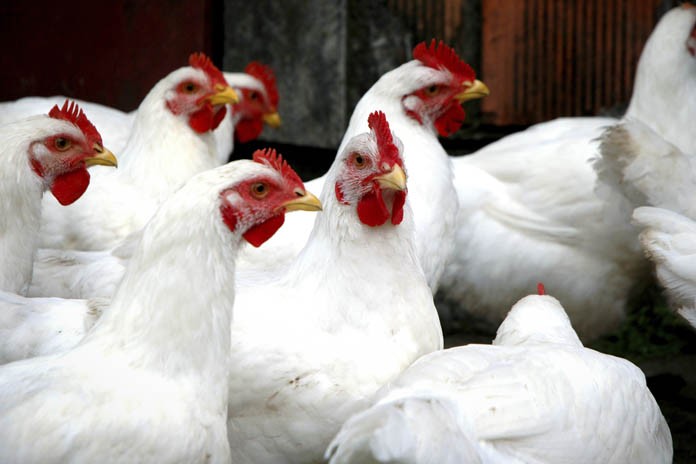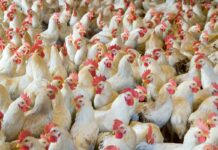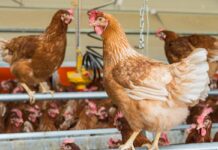
The quantity of glucose and amino acids absorbed from the small intestine is a function of dietary concentrations, feed intakes and digestibility coefficients. Moreover, the rates and sites of absorption of glucose and amino acids need to be taken into considerations of digestive dynamics. A tangible proportion of these absorbed nutrients are not transferred into the systemic circulation but are utilised by the gut mucosa for energy to drive digestive processes and for structural and secretional protein synthesis.
Glucose, glutamic acid and glutamine are important energy substrates but, to varying extents, the balance of amino acids undergoes catabolism to meet the copious energy requirements of the gut. The provision of balanced quantities of glucose and amino acids at protein deposition sites is critical for efficient growth. Therefore, the inherently different digestive dynamics of free versus protein-bound amino acids, and their post-enteral availability, should be taken into account. This is necessitated by the likelihood that free amino acids will be incorporated into broiler diets to increasing extents in the future.
The inclusion of free or synthetic amino acids in broiler diets, methionine, lysine and threonine, has been routinely practiced for decades. Now additional essential amino acids including arginine, isoleucine, tryptophan and valine are commercially available. The likelihood is that the increasing global protein demand for both human food and animal feed will continue to drive protein prices higher, which has been the case for soybean meal. Against this outlook, the prices for synthetic amino acids are relatively static or even declining.
This review is a speculative consideration of the implications of the probable increase in free amino acid inclusions in broiler diets in the interactive context of starch and protein digestive dynamics.
Background
Golberg and Guggenheim (1962) compared the digestion of amino acids and their appearance in portal circulation in rats offered casein or soy flour as protein sources. Both the small intestinal digestion and the entry into the portal circulation of lysine from casein were more rapid than from soy flour. Moreover, the data suggests that a greater proportion of lysine entered the portal circulation from casein, the more rapidly digested protein source. Thus differences in digestive dynamics of protein-bound amino acids exist between feedstuffs but differences between free and protein-bound amino acids will be of an even greater magnitude.
Free amino acids do not undergo digestion and are directly available for absorption in the upper small intestine and appear in the portal circulation more rapidly than protein-bound amino acids. Thus the digestive dynamics of free amino acids, that is the rate, quantity and site of absorption is very different to that of protein-bound amino acids.
It was subsequently demonstrated that the utilisation of free amino acids by broiler breeders fed once- or twice-daily was inferior on the same basis. An open question is how efficiently can broiler chicks utilise free amino acids?
Broilers are offered diets on an ad libitum basis and their feed intake under a ‘24-hours-ons’ lighting regime is ostensibly continuous. Pinchasov et al. (1990) reported that 7-21 day weight gains and feed conversions were compromised by offering chicks maize-based diets with increasing inclusions of free amino acids on an unrestricted basis but the lighting regime was not specified.
The definition of digestive dynamics in this review includes the digestion of nutrients in the gut lumen, absorption of end-products into the gut mucosa, and their post-enteral availability. This process involves both static and kinetic components and static ileal digestibility coefficients are used to calculate the kinetic parameters. That is the rate, quantity and site of absorption of glucose and amino acids along the small intestine. The rate of digestion may be deduced by fitting apparent digestibility coefficients and mean retention times in intestinal segments into an exponential mathematical model. The quantity of a nutrient absorbed at the terminal ileum (g/bird/day) or other intestinal segments is a simple function of feed intakes, dietary concentrations and digestibility coefficients.
The site of absorption may be defined as one of four small intestinal segments (proximal and distal jejunum, proximal and distal ileum) and the amounts of starch or protein that apparently disappear or are absorbed as glucose and amino acids may be deduced. In a recent study there was a negative linear relationship between starch:protein disappearance rate ratios and 40-day weight gains. The negatively correlation has an R2 value of 0.587; thus 59% of the variation in weight gain may be attributed to the disappearance rate ratio and, importantly, weight gains will be enhanced following an increase in the disappearance rate of protein (g/bird/day) relative to starch from the proximal ileum.
Intermittent feed intakes
Broiler chickens are fed ad libitum but this unrestricted access to feed does not equate to continuous feeding and feed intakes of broilers may be best described as intermittent and are also subject to lighting regimen. Broilers exhibit diurnal feeding patterns and consume most of their ration either at the start or end of the day. Jensen et al. (1962) found that chicks offered pelleted diets under a ‘12-hours-on’ lighting regime spent only 4.7% of illuminated time in eating and Fujita (1974) reported that chicks spent 10.8% of time eating under a ‘14-hours-on’ lighting regime.
Based on five of our studies, the average retention time in the jejunum and ileum was 2.98 hours. Coupled with the data of Denbow (2000) for retention times in the crop, proventriculus, gizzard, and duodenum, digesta reaches the terminal ileum in broilers in approximately 4.25 hours. Thus, despite essentially unrestricted access to feed in commercial production systems, intermittent feed consumption patterns still provide scope for asynchronies in digestion and absorption of nutrients in the small intestine to influence broiler performance.
Starch and protein digestion occurs mainly in the jejunum through which digesta will pass in approximately 3 hours; therefore, as lighting regimen influence feed consumption patterns and extended periods without illumination should intensify imbalances in digestive dynamics.
Amino acid catabolism
The efficient anabolic incorporation of amino acids into skeletal protein is the desired outcome for chicken-meat production. However, a substantial proportion undergo inevitable and preferential catabolism which represents a shortfall of amino acids for protein deposition. Estimates of lysine catabolism range from 20 to 24% in broiler chickens.
Poultry studies are limited but Watford et al. (1979) found that both glutamate/glutamine and glucose were oxidised in enterocytes but glucose generated 27% more oxygen in chicken enterocytes than glutamate/glutamine. Wu et al. (2005) even suggested that antimicrobial agents depress catabolism of dietary amino acids in enterocytes by reducing the intestinal mass and that this may be one mechanism for their growth promoting effects.
The implication is that catabolism of amino acids in the gut mucosa is manipulable and its reduction would trigger the entry of more amino acids into the systemic circulation to become available for protein accretion with a corresponding increase in the more efficient utilisation of glucose for energy provision to the gut.
Slowly digestible starch
Data has been generated to indicate that the provision of some slowly digestible starch, or starch digested in the lower small intestine, in broiler diets enhances feed conversion efficiency. More recently it was demonstrated that slowly or gradually digestible starch enhanced energy utilisation (AME, AMEn) in addition to FCR in sorghum-based broiler diets. Gradually digestible starch was defined as starch digested in the distal jejunum, proximal and distal ileum as opposed to the proximal jejunum.
The gastrointestinal tract consumes in the order of 20% of incoming dietary energy for digestive and absorptive processes and much of this energy is derived from catabolism of amino acids rather than glucose. Nevertheless, Fleming et al. (1997) found starch/glucose and glutamic acid/glutamine were approximately equally important energy substrates for small intestinal mucosal cells in the rat. Moreover, net ATP production from glucose was greater than glutamine by a two-fold factor. It follows that glucose from rapidly digested starch sources would be depleted in the upper small intestine, effectively forcing mucosal cells in the lower small intestine to catabolise amino acids for energy provision. Thus slowly digested starch sources would provide more glucose to the lower small intestine thereby sparing protein from oxidation and energy generation from glucose would be substantially more efficient than from amino acids.
Free amino acids
They do not require digestion and it follows that they will be rapidly and almost completely and rapidly absorbed in the upper small intestine to far greater extents than protein-bound amino acids. Schwartz et al. (1959) compared free and protein-bound lysine in chicks and at the highest level of supplementation, free lysine HCl supported nearly 20% greater weight gains than bound lysine in dehulled soybean meal.
The average digestion rate for nine essential amino acids was 2.96 kamino acidx10-2min-1 with the branched chain amino acids being noticeably slower. In contrast, methionine and lysine had a remarkably higher mean digestion rate of 4.83 kamino acidx10-2min-1 because of their dietary presence in both free and bound forms. Thus free amino acids accelerate ‘protein’ digestion rates relative to starch, which could provide a better post-enteral balance of glucose and amino acids for protein deposition.
While speculative, but perhaps importantly, free amino acids may be less susceptible to catabolism in the gut mucosa because of their proximal absorption in segments of the small intestine where more glucose is available as an alternative energy substrate. On the basis of the van der Meulen et al. (2007) data, this would apply especially to tryptophan and lysine, less so to threonine, valine and isoleucine and least to methionine and arginine. If, in fact, free tryptophan and lysine are less prone to catabolism in the gut mucosa than their protein-bound counterparts, then the implications are quite profound.
In general terms, increasing usage of free amino acids will benefit chicken-meat production because they will attenuate the impact of escalating protein meal prices which is pivotal. Free amino acids will facilitate the fine-tuning of least-cost ration formulations in respect of key digestible amino acid ratios, including lysine, arginine and branched-chain amino acids. In addition, free amino acids should increase the overall rate of “protein” digestion relative to that of starch which may be of benefit. More specifically, a potential advantage is that the propensity of free amino acids to undergo catabolism in the gut mucosa may be less than protein-bound amino acids because of the more proximal absorption of free amino acids in the small intestine. This would result in the inherently more efficient derivation of energy from glucose to drive digestive processes.
Alternatively, a potential disadvantage is that free amino acids may lead to an unbalanced provision of free and bound amino acids at sites of protein deposition which would compromise the utilisation of both the specific and the balance of amino acids. However, this impact would appear to be largely dependent on consumption patterns under ostensibly ad lib feeding regimes and whether or not broiler chickens are continuous or discontinuous feeders.
Feeding patterns may be modified by more extended patterns of illumination and the practice of whole grain feeding may encourage more continuous feed intakes than intact pellets. Certainly, investigations into these possible positive and negative outcomes are justified as the likelihood is greater advantage can be taken from the use of free amino acids following the development of a better appreciation of their role in starch and protein digestive dynamics. Nevertheless, in overall terms, the roll-out of more free amino acids should be a positive development for the chicken-meat industry.
From APSS proceedings
















